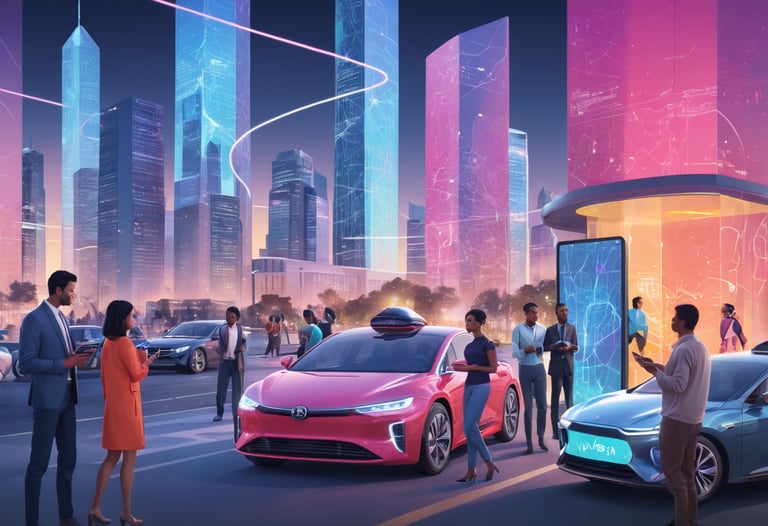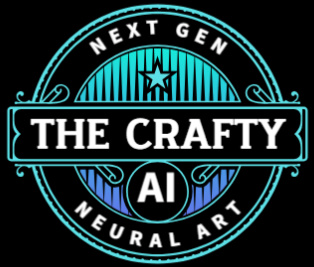How AI is Changing Everyday Life
Dive into how AI transforms daily life with smart alarms, personalized shopping, workplace efficiency, and government services. Explore its applications, benefits, and ethical considerations for enhanced convenience and personalization.
AI IN OUR WORLD


Artificial Intelligence (AI) has seamlessly woven itself into the fabric of our daily lives, transforming the way we work, communicate, shop, relax, and even interact with government services. From the moment we wake up to the time we go to bed, AI is quietly enhancing our routines, often in ways we barely notice. This blog post explores the profound impact of AI on our everyday activities, highlighting its role in making life more convenient, efficient, personalized, and better governed.
Waking Up to an AI-Powered Morning
Your day likely begins with AI before you even open your eyes. Smart alarms, like those integrated into apps such as Sleep Cycle, use AI to analyze your sleep patterns and wake you during your lightest sleep phase, ensuring you start the day refreshed. These apps rely on machine learning algorithms to interpret data from your phone’s sensors or wearable devices, adapting to your unique sleep habits over time.
As you reach for your phone, AI-powered virtual assistants like Siri, Google Assistant, or Alexa are ready to streamline your morning. A simple voice command can provide a weather update, read your calendar, or play your favorite morning playlist. These assistants use natural language processing (NLP) to understand your requests and deliver accurate, context-aware responses. For instance, asking, “What’s my day like?” prompts the assistant to summarize your schedule, traffic conditions, and even suggest an outfit based on the weather forecast.
Navigating the Commute with AI
AI continues to shape your morning as you head to work or school. Navigation apps like Google Maps or Waze rely on AI to analyze real-time traffic data, predict delays, and suggest the fastest routes. These apps process vast amounts of information from GPS signals, user reports, and even historical traffic patterns to optimize your commute. Machine learning models also predict potential road hazards, such as construction or accidents, ensuring you arrive on time.
For those using public transportation, AI enhances efficiency here too. Apps like Citymapper use AI to recommend the best combination of buses, trains, or rideshares, factoring in real-time transit schedules and disruptions. In some cities, AI-powered systems optimize traffic light timings or manage autonomous shuttles, reducing congestion and improving urban mobility.
AI at Work: Boosting Productivity
In the workplace, AI is revolutionizing how we tackle tasks. Tools like Grammarly and Microsoft Editor use AI to enhance writing by suggesting grammar corrections, style improvements, and even tone adjustments. These tools rely on NLP to understand context and provide real-time feedback, helping professionals craft polished emails or reports.
AI-powered project management tools, such as Asana or Trello, use predictive analytics to prioritize tasks, estimate project timelines, and allocate resources efficiently. For example, these platforms can analyze past project data to identify potential bottlenecks and suggest adjustments, saving time and reducing stress.
In creative fields, AI is a game-changer. Designers use tools like Adobe Sensei to automate repetitive tasks, such as resizing images or generating design variations, freeing up time for more creative work. Similarly, marketers leverage AI-driven platforms like HubSpot to analyze customer behavior, personalize campaigns, and predict which strategies will yield the best results.
Shopping and Personalization
AI has transformed the way we shop, both online and in physical stores. E-commerce giants like Amazon use recommendation engines powered by machine learning to suggest products based on your browsing history, purchases, and even items in your cart. These algorithms analyze vast datasets to predict what you’re likely to buy, creating a highly personalized shopping experience.
In physical stores, AI enhances the customer experience through smart mirrors, inventory management, and checkout-free systems. For example, Amazon Go stores use computer vision and sensor fusion to allow customers to shop and leave without waiting in line, as AI tracks items picked up and automatically charges your account.
Price comparison tools, like Honey or CamelCamelCamel, use AI to track price fluctuations across retailers, ensuring you get the best deal. Meanwhile, fashion apps like Stitch Fix employ AI to curate personalized clothing selections based on your style preferences, body measurements, and feedback, making shopping effortless and tailored.
AI in Entertainment and Leisure
After a long day, AI enhances how we unwind. Streaming platforms like Netflix, Spotify, and YouTube rely on AI to recommend movies, songs, or videos tailored to your tastes. These platforms use collaborative filtering and deep learning to analyze your viewing or listening history, as well as patterns from millions of other users, to suggest content you’re likely to enjoy.
Gaming has also been transformed by AI. In games like The Last of Us Part II, AI-driven non-player characters (NPCs) exhibit realistic behaviors, adapting to player actions to create immersive experiences. Meanwhile, AI tools like NVIDIA’s DLSS use deep learning to upscale graphics in real-time, delivering stunning visuals without sacrificing performance.
For those who enjoy creating content, AI tools like Canva or Lumen5 simplify video editing and graphic design. These platforms use AI to suggest layouts, color schemes, or even generate short videos from text inputs, empowering amateurs and professionals alike to produce high-quality content.
Health and Wellness: AI as a Personal Coach
AI is revolutionizing how we care for our health. Wearable devices like Fitbit or Apple Watch use AI to track activity, monitor heart rate, and even detect irregular health patterns, such as atrial fibrillation. These devices analyze data in real-time, providing insights and nudging you toward healthier habits, like standing up after prolonged sitting or meeting your daily step goal.
Mental health apps, such as Woebot or Headspace, leverage AI to offer personalized mindfulness exercises or cognitive behavioral therapy (CBT) sessions. These apps use NLP to understand user inputs and provide empathetic responses, making mental health support more accessible.
In healthcare, AI assists with diagnostics and treatment planning. Tools like IBM Watson Health analyze medical records and research papers to help doctors identify potential diagnoses or recommend treatments. While these systems don’t replace human expertise, they augment it, improving accuracy and efficiency.
AI in the Home: Smart and Efficient Living
Smart home devices are perhaps the most tangible way AI integrates into daily life. Thermostats like Nest learn your temperature preferences and adjust automatically to save energy while keeping you comfortable. AI-powered security systems, such as Ring or Arlo, use facial recognition and motion detection to monitor your home, sending alerts for unusual activity.
In the kitchen, AI-driven appliances like smart refrigerators track inventory and suggest recipes based on available ingredients. Voice-activated devices, like Amazon Echo, integrate with these systems, allowing you to control lights, order groceries, or even start your coffee maker with a simple command.
AI in Government: Streamlining Public Services
AI is increasingly playing a vital role in how governments serve citizens, improving efficiency and accessibility in public services. Government agencies use AI to streamline administrative processes, such as processing tax returns, issuing permits, or handling social service applications. For example, AI-powered chatbots on government websites can answer citizen queries about services, from renewing a driver’s license to applying for benefits, reducing wait times and freeing up staff for more complex tasks.
In law enforcement, AI tools like predictive policing algorithms analyze crime data to identify high-risk areas, helping agencies allocate resources more effectively. However, these systems must be carefully designed to avoid biases, ensuring fair and equitable outcomes. Similarly, AI is used in judicial systems to assess case backlogs and prioritize hearings, improving access to justice.
Urban planning benefits from AI through smart city initiatives. AI systems analyze data from sensors, cameras, and citizen feedback to optimize waste management, energy usage, and public transportation. For instance, Singapore’s Smart Nation program uses AI to monitor traffic flow and reduce congestion, enhancing the quality of life for residents.
AI also aids in disaster response and public safety. Machine learning models predict natural disasters like hurricanes or floods by analyzing weather patterns and historical data, enabling governments to prepare and evacuate communities more effectively. During crises, AI-powered drones and robots can assess damage in hard-to-reach areas, providing real-time data to first responders.
The Invisible Hand of AI: Automation Behind the Scenes
Beyond the obvious applications, AI works behind the scenes to power many services we take for granted. Email filters use AI to detect spam or phishing attempts, analyzing patterns in message content and sender behavior. Social media platforms like X employ AI to moderate content, detect misinformation, and personalize your feed based on your interactions.
Financial services also rely heavily on AI. Fraud detection systems analyze transaction patterns to flag suspicious activity in real-time, protecting your bank account. Robo-advisors, like Betterment, use AI to manage investments, balancing portfolios based on market trends and your risk tolerance.
Ethical Considerations and the Future of AI
As AI becomes ubiquitous, it raises important questions about privacy, bias, and accountability. For instance, recommendation algorithms can create echo chambers, reinforcing existing beliefs by showing only similar content. In government applications, biased AI systems could lead to unfair resource allocation or discriminatory outcomes if not carefully monitored. Facial recognition systems, used in both public and private sectors, have faced scrutiny for potential biases, particularly in law enforcement applications. Addressing these challenges requires transparent AI development, regular audits, and robust regulations to ensure fairness and protect user data.
Looking ahead, AI’s role in daily life will only grow. Innovations like autonomous vehicles, advanced robotics, and AI-driven healthcare could further transform our routines. In government, AI could enhance citizen engagement through personalized public services or improve policy-making by analyzing large-scale socioeconomic data. For example, self-driving cars could make commutes safer and more productive, while AI-powered personal assistants might evolve into proactive companions, anticipating needs before you even voice them.
Conclusion
AI is no longer a futuristic concept—it’s an integral part of our daily lives, enhancing everything from our morning routines to our interactions with government services. By automating mundane tasks, personalizing experiences, providing actionable insights, and improving public administration, AI empowers us to live more efficiently and creatively. As technology advances, the key will be to harness AI’s potential responsibly, ensuring it continues to enrich our lives while addressing ethical concerns. Whether you’re navigating traffic, streaming a movie, tracking your fitness goals, or accessing government services, AI is there, quietly shaping your day for the better.
You might also enjoy this article on Will AI Replace Your Job? What you need to know.

